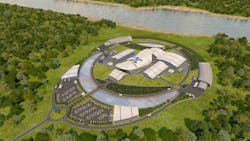Nuclear-Powered Data Centers: Modular Reactors on the Horizon
Early 2023 has seen a lot of public statements about nuclear-powered data centers. It sounds high tech and futuristic, but it’s important to understand the reality of the situations being discussed for short-term use. We aren’t looking at dedicated nuclear reactors running individual data centers, but rather data center campuses being colocated with existing nuclear power plants.
The data center industry's nuclear options will evolve in coming years with the commercial development of small modular reactors (SMR) with the potential to provide on-site power for large campuses. The rising profile of SMR is highlighted by today's announcement that a huge U.S. utility, the Tennessee Valley Authority (TVA) will work with several partners to advance the global deployment of small modular reactors.
The current projects are focused on proximity to existing nuclear facilities. In mid-January, Cumulus Data announced that it has completed the shell for a 48-megawatt (MW) data center with a direct connection to the Susquehanna Steam Electric Station, a nuclear power plant in Northeast Pennsylvania. The facility isn’t one of the more recent nuclear plants in the US, with Unit 1 going online in 1983 and Unit 2 in 1985.
With the plant being capable of generating 2.5 GWh annually (1.257 GWh per unit), Cumulus plans to add two additional 48MW shells in their Phase 1 development, building towards an eventual aggregate development of 475 MW of capacity. This is very aggressive planning and the anchor customer is the zero-carbon bitcoin miner TeraWulf, who believe they will ramp up to 50MW of net mining capacity in early 2023.
Proximity Offers Reliability, Cost Benefits
Perhaps the biggest advantage of the direct connection to the nuclear power station is the removal of any intermediation by legacy transmission and distribution systems. This increases reliability and also generally reduces the cost of the power. If there is any potential for concern in might be in the operating licensing of the power station itself, with it’s most recent license renewal expiring in 2029. The current demand for power makes it unlikely that further renewals will be an issue, but as future nuclear power is impacted by political as well as technical concerns, it is one that businesses will need to monitor.
A name very familiar to the data center industry, Dominion Energy, is planning to build a data center campus adjacent to its Millstone Nuclear Power Station in central Connecticut. With just over 2 GW of available power, the current plan is for developer NE Edge to build two data center buildings, the first with over one million square feet of available space, the second with 400,000 SF.
At this point no statement has been made to actual power availability at each facility. Millstone has been in operation since the mid-1960s, although their original reactor unit was decommissioned in 1995. Unit 2, an 869 MW reactor, has been in service since 1975, and Unit 3, a 1.2 GW system, has been running since 1986. Both units are licensed to continue operating for the next 15 to 20 years. It’s expected that the Millstone data centers would see similar advantages to those announced by Cumulus Data. No potential customers for this project have been announced at this time.
Nuclear-Powered Data Centers are on the Horizon
A data center with its own, dedicated, nuclear power plant is no longer something out of science fiction. In late 2023 the Nuclear Regulatory Commission (NRC) made the decision to allow small modular reactors (SMR) to be located closer to higher population density areas, and in mid-January 2023 the NRC issued the final ruling on the NuScale Small Modular Reactor Design Certification. This led to the announcement at the end of January that a group of partners led by GE Hitatchi had the first commercial contract for grid-scale SMR, with units capable of providing up to 300 MW. Plans are for this first unit to be deployed by Ontario Power generation at their site in Clarington, Ontario. The NuScale SMR can provide up to 50MW per individual unit.
The US Department of Energy is working with the Utah Associated Municipal Power Systems to get the first demonstration system in the US, a NuScale SMR, up and running at the Idaho National Lab, by 2029, with a full-scale grid system running by the following year
Closer to home, the TVA (Tennessee Valley Authority) announced today that it is partnering to advance the global deployment of modular reactors. TVA has also been exploring the possible licensing and deployment of a NuScale SMR at their research site in Oak Ridge, Tennessee.
The TVA is teaming with GE Hitachi Nuclear Energy (GEH), Ontario Power Generation (OPG) and Synthos Green Energy (SGE) to invest in the development of the GEH BWRX-300 small modular reactor.
"“Working together, we are taking intentional steps to advance new nuclear in the U.S. and around the world," said TVA President and CEO Jeff Lyash. "TVA is leading the way for the nation by investing and helping to shape the standard design of the GEH BWRX-300, which will add more reliable, resilient, affordable and clean energy on the grid,."
On Thursday, Last Energy announced a deal to sell 24 small modular reactors to UK customers.
While the current NuScale SMR design deployment plans are targeted for operation in 2028, the advantages of the SMR technologies, which can range from 10 MW microreactors to 12 unit clusters of of “standard” 50 MW SMRs, are not simply in the much shorter time periods from the decision point to go nuclear to power generation, but also the capability to really take advantage of the “modular” part of the designs. These reactors are designed to be able to be prefabricated, the entire system being constructed in a factory to the standard specification and deployed on site.
As the technologies mature it is even possible that not only could SMRs bring power to more remote areas and their associated edge data centers, but that microreactors could be deployed as backup power for more traditional data centers, replacing diesel generators with their much more carbon and environmentally clean footprint.
In the official announcement of the NRC ruling on the NuScale SMRs, Assistant Secretary for Nuclear Energy, Dr. Kathryn Huff made the reality perfectly clear. “SMRs are no longer an abstract concept, they are real and they are ready for deployment thanks to the hard work of NuScale, the university community, our national labs, industry partners, and the NRC. This is innovation at its finest and we are just getting started here in the U.S.!”
About the Author



